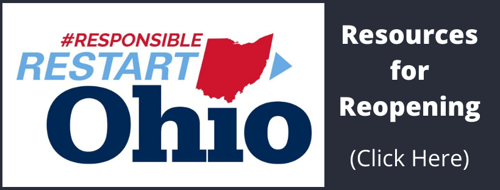responsible RESTART OHIO
Since Governor Dewine’s initial announcement on April 27, 2020, of the first stages of Ohio’s plan to responsibly restart Ohio’s economy during the ongoing COVID-19 pandemic, The Ohio Department of Health has issued and maintained sector-specific guidance for a wide range of businesses and activities in re-opening and operating safely.
Responsible RestartOhio is about:
- Protecting the health of employees, customers, and their families
- Supporting community efforts to control the spread of the virus
- Leading in responsibly getting Ohio back to work.
Click the link below to access the most up-to-date listing of specific operating requirements and recommendations for responsibly re-opening and operating business, education, entertainment, and other activities as part of Responsible RestartOhio.
Still have questions about safe operating protocols for your business or event? Click here to contact the Lake County General Health District.
CARES Act Relief Program
Are you a small business owner facing an unprecedented economic disruption due to the Coronavirus (COVID-19) outbreak? The President has signed into law the CARES Act, which establishes several new temporary relief program options that may be available for your business. Find more information on the U.S. Small Business Administration Website at: https://www.sba.gov/page/
SBA Coronavirus Pandemic Disaster Loans Comparison (PDF)
Governor Dewine has allocated portions of the CARES Act funding in Ohio into the following three programs:
- The Small Business Relief Grant – providing assistance to small businesses
- The Bar and Restaurant Assistance Fund – providing assistance to on-premise liquor permit holders
- The Home Relief Grant – providing assistance to Ohioans who are behind on rent, mortgage, and water and/or sewer utility bills
Find further information and how to apply for these programs at: https://businesshelp.ohio.gov/
CDC reopening decision tools and guidance for cleaning and disinfecting public spaces, workplaces, businesses, schools, and homes
Creating a safe environment for your employees
There are many precautions you can take to make sure that your employees have a safe work environment. But you can’t do it alone. Stress to your employees the importance of hygiene in the workplace.
- Update your organization’s emergency operations plan and share it with employees.
- Create a flexible sick leave policy so employees feel they are able to stay home from work when they are sick. And actively encourage them to do so.
- Establish a plan to communicate information to employees about your infectious disease outbreak response plan.
- Share up-to-date information with your employees regarding coronavirus.
- Develop a plan if someone becomes ill with coronavirus during work, such as having a secure room for them to go, away from all other employees and clients.
- If feasible, consider giving your employees the option to work remotely.
- If employees working remotely is not feasible for your organization, consider staggering shifts, etc.
- Cancel any large group meetings or events happening at your workplace.
- Warn employees of the dangers of traveling and limit their need to travel as much as possible.
- Encourage employees to frequently wash their hands with soap and water for 20 seconds.
- Provide alcohol-based hand sanitizer throughout your workplace to make it easy for employees to frequently sanitize their hands.
- Provide boxes of tissues and waste baskets throughout the workplace. Encourage employees to use tissues to cover their cough or sneeze., then to immediately throw the tissue away and wash their hands with soap and water afterward.
- Stress the importance of not touching their eyes, nose, or mouth.
- Be sure to thoroughly clean all frequently touched surfaces. This may include cash registers, door knobs, light switches, equipment, computers, desks, faucet handles, phones, countertops, workstations, remote controls, etc.
Reference: Centers for Disease Control and Prevention
Creating a safe environment for your Customers
There are many things you can do to create a safe environment for the customers and patrons of your businesses during the outbreak of the coronavirus.
- Be sure all employees are washing their hands frequently with soap and water for 20 seconds, especially those handling money or food.
- Make sure employees know to avoid touching their eyes, nose, or mouth.
- Encourage employees to cover their coughs and sneezes with a tissue and immediately dispose of the tissue afterward. Provide boxes of tissues and waste baskets around the workplace to make it easy for employees to do this. Also stress the importance of washing your hands with soap and water after sneezing or coughing.
- Actively encourage employees to stay home from work if they are sick. Be sure to provide enough flexibility in sick leave policies for your employees to be able to do this.
- Provide hand sanitizer stations throughout your workplace, so that employees and customers can sanitize their hands often. Be sure it is an alcohol-based hand sanitizer with at least 60% alcohol.
- Be sure to thoroughly clean all frequently touched surfaces. This may include cash registers, door knobs, light switches, equipment, computers, desks, faucet handles, phones, countertops, workstations, remote controls, etc.
- In the instance that an employees begins showing symptoms of coronavirus during work, create a secure room for them to go until they are able to go home to prevent the spread to other employees and customers.
- Consider canceling any large group meetings or events to prevent the spread of coronavirus.


